This article was medically reviewed by Luba Lee, FNP-BC, MS. Luba Lee, FNP-BC is a Board-Certified Family Nurse Practitioner (FNP) and educator in Tennessee with over a decade of clinical experience. Luba has certifications in Pediatric Advanced Life Support (PALS), Emergency Medicine, Advanced Cardiac Life Support (ACLS), Team Building, and Critical Care Nursing. She received her Master of Science in Nursing (MSN) from the University of Tennessee in 2006.
This article has been viewed 14,820 times.
If you’ve injured your joint and feel pain, swelling, or bruising, you might have a sprain. Although ankle sprains are the most common type of sprain, you can also sprain your wrist, knee, foot, thumb or other fingers. If the pain and swelling are severe, contact your doctor. For minor sprains, rest the area, apply ice, wrap the sprain with a compression bandage, keep it elevated, stay hydrated, eat an anti-inflammatory diet, and practice stress reduction to heal quicker. Mild sprains should heal within a few weeks, but a severe sprain can take several months to heal. Consult with your doctor about building a rehabilitation plan to recover from the injury.
Steps
Treating the Sprain in the First 48 Hours
-
1Contact your doctor if your symptoms are severe. If you can’t bear any weight on the injured joint, can’t move it, or you feel numbness in the area, this may be a sign that the ligament has torn completely or you have broken a bone. Seek medical attention immediately. Put an ice pack on the area on the way to your doctor.[1]
- Severe swelling, such a when your joint appears twice its size or feels hot to the touch, or pain in the area can also mean you have a serious sprain that should be treated by a doctor. Compare your injured joint to your non-injured joint to determine how badly it's swollen.
- If you have a fever or any open cuts around the injury, see a doctor immediately to rule out a broken bone and prevent infection. The doctor can do an X-ray or MRI to determine the extent of your injury.
- If you notice redness and heat around the injury, it may be a sign of infection. Contact your doctor immediately.
- If the same joint has been sprained or injured before, it’s best to see a doctor even if it seems like you have a minor sprain. Your doctor can help you avoid any complications with your current injury and prevent it from happening again in the future.
-
2Rest the sprained joint to prevent further injury and let it heal. Don’t put any weight on the area for at least 48 to 72 hours. After this period, and once the swelling has gone down, you can start gently using the injured joint again.[2]
- If you have a sprained ankle or knee, you may want to use crutches for the first couple of days. Talk to your doctor to find the best solution.
- Rest a sprained wrist by putting your arm in a sling.
- Tape a sprained finger or toe to the adjacent one to keep it immobile, or splint it with at homemade or commercial splint. You can also wrap a sprained thumb with a bandage to let it rest.
Advertisement -
3Ice the joint for 15-20 minutes 4-8 times per day to reduce the swelling. Apply ice, an ice pack, or a bag of frozen vegetables on the area as soon as you can after your injury. Don’t put ice directly on your skin. Instead, wrap an ice pack in a thin towel. Leave it on the injury for 15-20 minutes. Repeat this every few hours for the first 48 hours after the injury, or until the swelling goes down.[3]
- Be extra gentle with your sprain after you’ve iced it. You won’t feel as much pain or discomfort but you should still rest.
- Avoid icing your sprain if you have an open or infected wound, hypersensitivity to cold, acute dermatitis or eczema on the injured joint, impaired circulation, Raynaud’s disease, or lack of skin sensitivity.[4]
-
4Wrap the joint to stabilize it and further reduce swelling. Wrap an elastic or neoprene bandage around the joint several times. Don’t wrap too tightly. You want the bandage to feel snug without squeezing or pinching.[5]
- It's best to have someone wrap the joint for you, as it's very difficult to do it correctly on your own.
- Find elastic bandage and special compressive sleeves for your ankle or wrist in your local pharmacy.
-
5Elevate the joint to let gravity help the healing process. If possible, keep the joint raised above heart level as often as you can over the first few days. You can elevate the area while you ice and compress the injury. This way, gravity will help to bring fluid away from the injury to reduce swelling and speed healing.[6]
Healing and Rehabilitating the Sprain
-
1Take an over-the-counter pain reliever to reduce any discomfort. Immediately after your sprain, take an anti-inflammatory painkiller like ibuprofen or aspirin to ease the pain and reduce swelling. As your sprain heals, take ibuprofen (such as Advil) or acetaminophen (such as Tylenol) to help reduce the pain. Read the label on your pain reliever and follow the listed dosage instructions.[7]
- You can also find anti-inflammatory pain relievers as topical creams or patches that you can apply directly to the sprain for targeted pain relief.
- You can also try using natural herbs and spices for inflammation. Try using ginger, turmeric, chili pepper, and green tea.[8]
-
2Apply heat to the sprain after 72 hours to promote healing. While ice can be great at reducing the swelling of a sprain, heat can be useful after the swelling goes down to increase blood flow to the joint. This will help get the necessary nutrients to the area and take away cell waste to speed recovery. Wrap a damp towel around a hot pack. Cover this with a dry towel and then apply it to the sprained joint. Keep on the area for 15-20 minutes. Repeat 4-5 times per day, as needed.
- Sitting in a sauna or steam room for 15-20 minutes is also a great way to give your injury some heat therapy.[9]
- Don’t use heat therapy on your sprain if you have a decreased sensation to heat, impaired circulation, open wounds, cancer, or a tuberculosis lesion in the area where you are applying heat.
-
3Begin using the joint again gently, as the pain and swelling subside. Depending on the severity of the sprain, it can take a few days to a few months to recover fully. After the initial swelling has gone, usually a few days after the injury, you can start to gently move the joint again. Gentle movement will help restore its strength and stability before you go back to your normal activities.[10]
- If you have a moderate or severe sprain, it’s best to consult with your doctor or physiotherapist to come up with the right rehabilitation exercises to rebuild strength and stability in the joint. This will speed the healing process and minimize the risk of reinjuring the area.
-
4See your doctor if your sprain isn’t getting better after 2-3 days. Sometimes what feels like a sprain can be another serious injury, like a fracture. If you don’t feel your sprain steadily getting better after a few days, contact your doctor.[11]
Things You'll Need
Treating the Sprain during the First 48 Hours
- Ice pack
- Thin towel
- Elastic bandage or a compressive sleeve made for your specific sprain
Healing and Rehabilitating
- Over-the-counter pain reliever
- Heat pack
- 2 towels
References
- ↑ https://www.mayoclinic.org/first-aid/first-aid-sprain/basics/art-20056622
- ↑ https://www.uofmhealth.org/health-library/tw4354spec
- ↑ https://www.uofmhealth.org/health-library/tw4354spec
- ↑ https://www.pthealth.ca/hot-and-cold-treatment-for-sprains-and-strains/
- ↑ https://www.mayoclinic.org/first-aid/first-aid-sprain/basics/art-20056622
- ↑ https://www.uofmhealth.org/health-library/tw4354spec
- ↑ https://www.niams.nih.gov/health-topics/sprains-and-strains#tab-treatment
- ↑ https://www.ncbi.nlm.nih.gov/pmc/articles/PMC3011108/
- ↑ https://www.pthealth.ca/hot-and-cold-treatment-for-sprains-and-strains/
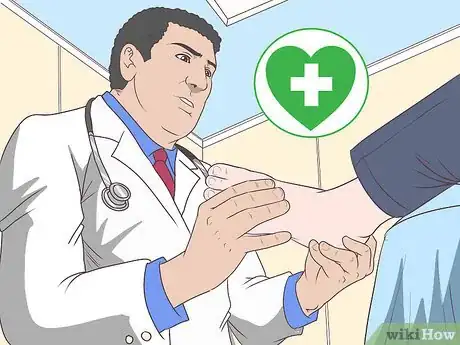

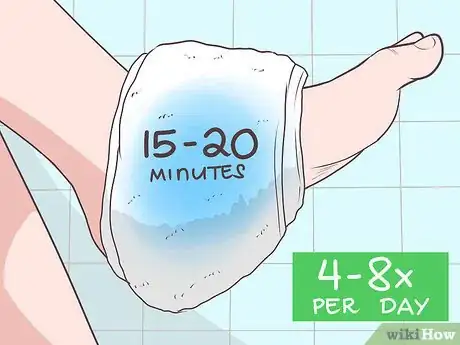
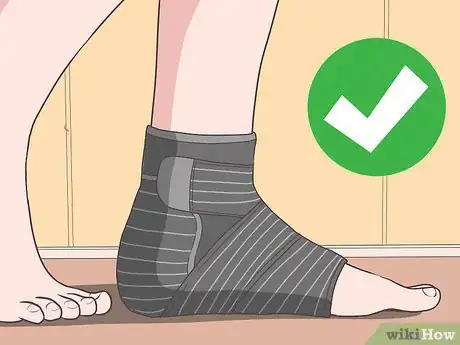
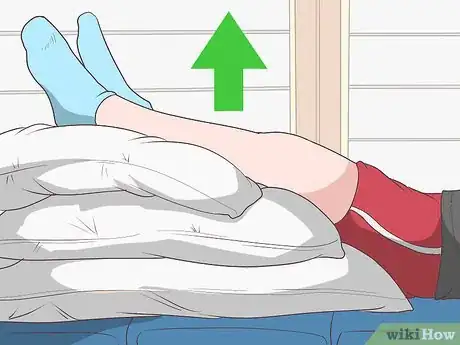


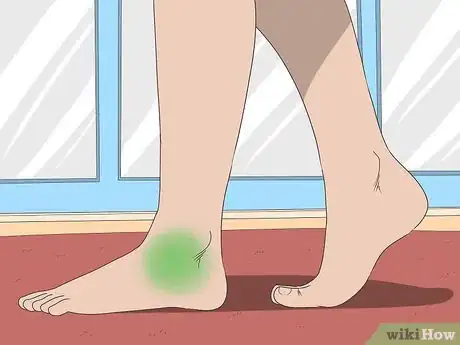

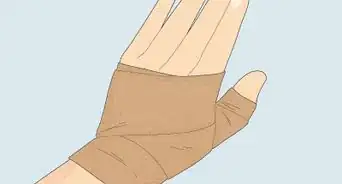
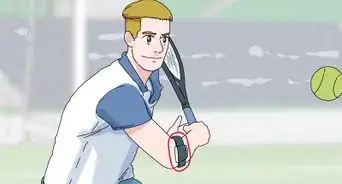
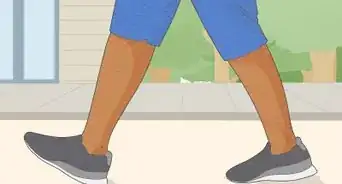
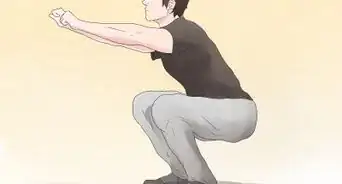


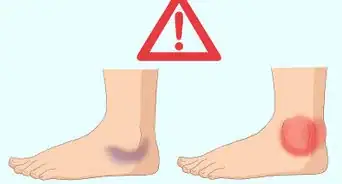
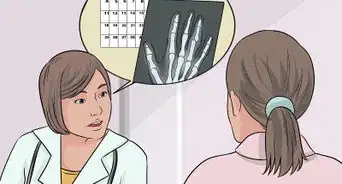
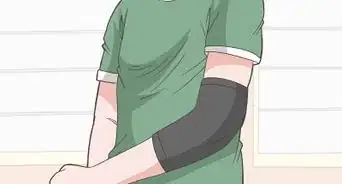



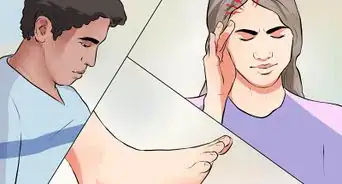















































Medical Disclaimer
The content of this article is not intended to be a substitute for professional medical advice, examination, diagnosis, or treatment. You should always contact your doctor or other qualified healthcare professional before starting, changing, or stopping any kind of health treatment.
Read More...